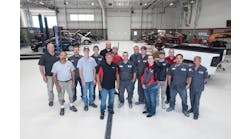A new software platform for collision repair shops, adasThink, which scans estimates to identify advanced driver-assistance system calibrations needed to properly complete repairs, released a study that shows many needed ADAS calibrations are routinely missed in body shops.
The study, which focused on Canadian collision repair shops in all the country’s provinces, and included a range of OEMs including Ford, Lexus, Mercedes-Benz, Honda, and Toyota, found that 88 percent of calibrations were missed in estimates at the shops included in the study.
The founder of the Toronto-based software platform, Nick Dominato, says the survey’s results are in line with what he expected, because of how new ADAS calibrations are in the collision repair industry and because it’s difficult to nail down when they need to be done.
“I can’t say it was surprising,” says Dominato, “it was right around where I estimated it to be.”
According to a release from adasThink, the study looked at 100 estimates “with known, required advanced driver-assistance systems (“ADAS”) calibrations.” The release says 85 of the 100 estimates did not contain a line item for an ADAS calibration.
Of the 122 ADAS calibrations known to be needed in the estimates, only 15 were identified, the release says. That makes for an identification rate of 12 percent.
Other points from the release included:
“—Of the 15 estimates that did include an ADAS calibration, 9 of those 15 estimates included a replacement of the ADAS sensor itself—a virtually impossible-to-miss ADAS calibration.
—Only 6% of estimates (or 5% of all ADAS calibrations) find an ADAS calibrations where there is a non-obvious calibration requirement.
—Even though 85% of the estimates missed the ADAS calibration, 66% of estimates contained a line item for a post-scan, while 56% included both a pre- scan and a post-scan.”
The study also puts into context the importance of ADAS and the technology’s logical end with respect to the collision repair industry.
“It’s trite now to say that the promise of ADAS (and driverless cars, the natural end state of ADAS) for society is potentially breathtaking. This includes saving over 350,000 lives in the United States annually, and reshaping our cities, work, and our homes. Today, ADAS systems are a core part of how new vehicles are marketed by OEMs, how they’re priced to consumers, and how they operate and are expected to operate on the road by consumers.
“Unfortunately, ADAS systems are not a core part of how vehicles are fixed in the collision industry as a whole. Yet.”



